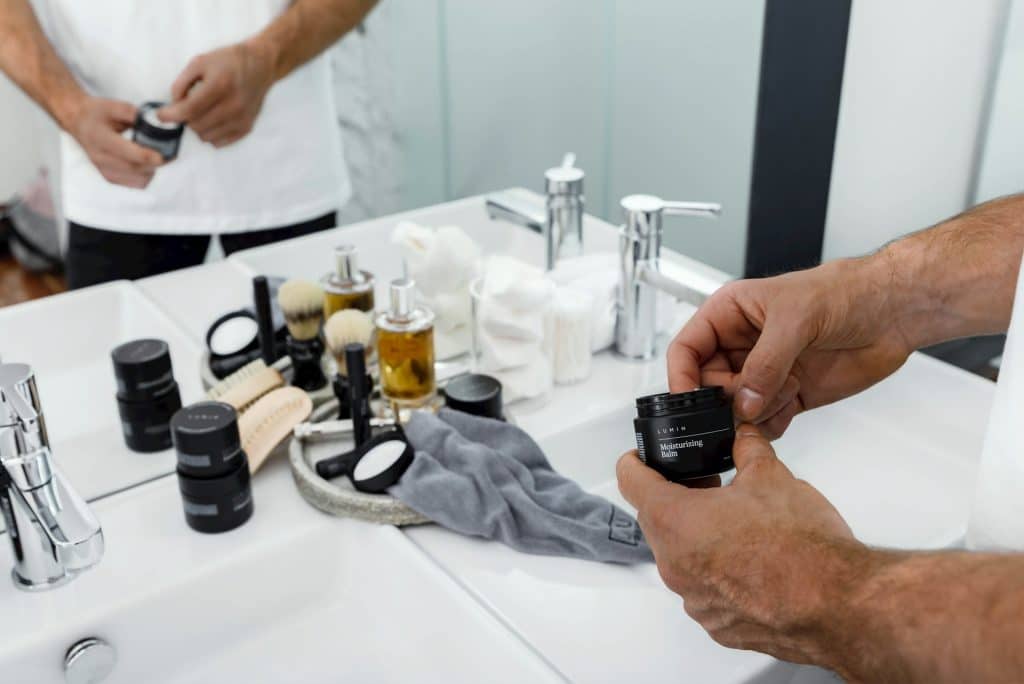Throughout the world, teenagers stare endlessly at their phone cameras, looking for the perfect angle by tilting their heads and inspecting their jawlines. They scroll endless TikTok videos with captions reading “keep mewing and be a chad”, and “bring your ex-girlfriend back by developing hunter eyes”. The comments on the video range from admiration to concern, but engagement algorithms don’t care. Thousands of likes, reposts and affirmations act as constant echo chambers reinforcing the “For You” page. Keep scrolling, and you will start finding more routines that increasingly border on hazardous.
Welcome to ‘looksmaxxing’, an endless void of beauty routines aimed primarily at younger audiences. Looksmaxxing was initially born out of incel (involuntarily celibate) forums, but exploded across social media, combining self-improvement trends with pseudoscience.
One former devotee of looksmaxxing is Darius Ng, a student at Singapore Management University. Darius recounts his story of being belittled for being under 165cm tall. “How are you going to find a girlfriend like this?” he recalled being asked often throughout his polytechnic to early university days.
From there, he stumbled across a Reddit thread claiming to improve your looks beyond just height – it seemed innocent enough, and he was hooked instantly. As someone who was always self-conscious, Darius concluded that his bad luck with romance was the unfortunate result of being below average height. Looksmaxxing offered an alternative viewpoint, where he could compensate for his short stature by making other changes to his looks.
Darius fully embraced the trend, starting with a disciplined skincare routine, then moving on to facial exercises and ‘proper’ tongue placement. “It allowed me to improve parts of myself that could be controlled,” he told me. However, this slowly became an obsession with his looks and self-worth.
Darius’s experience is not uncommon; it reflects a wider phenomenon of a generation of young men struggling with growing insecurities, made worse by a highly visual digital culture. They turn to quick hacks, hoping not only to improve themselves, but to also meet increasingly impossible beauty standards.
To understand how looksmaxxing became popular, we must trace its roots to the underlying anxieties of the digital generation. The term “looksmaxxing” originated from online communities like Reddit’s r/LooksmaxingAdvice, and infamous incel forums. Young men who are isolated and often confused about their lives and place in the social hierarchy find themselves landing in these communities, exposing themselves to extreme theories about dating, attraction, and the role physical appearance plays in establishing social status.

At first glance, looksmaxxing seems to be just another form of self-improvement, focusing on skincare, proper grooming and fitness. But it turns stranger the further down the rabbit hole you go. As the communities grew larger, looksmaxxing began to promote radical and often dangerous practices. These include “mewing” (where specific tongue posture techniques claim to sharpen your jawline), “bone smashing” (applying repeated blunt trauma to the face to stimulate bone growth), and “hunter eyes” (specific facial exercises aimed at developing a deep-set, predatory gaze).
What separates looksmaxxing from other self-improvement and beauty trends is its focus on ‘hyper-masculine’ traits. It is about achieving the optimal and ideal version of yourself – informally known as becoming a “chad”, someone with dominant facial structures built symmetrically, pronounced cheekbones and sharp jawlines. The goal isn’t just to look good; it’s to dominate and beat the competition socially and romantically.
TikTok and Instagram have turned these ideas into short-form and visually appealing content, showing before and after pictures edited by filters, day-in-the-life looksmaxxing routines, and influencers who monetise affiliate links for supplements, jaw trainers and other devices. Social media algorithms reward extreme content, and young men, many of whom feel inadequate and have low self-confidence find comfort in what looksmaxxing promises: control, transformation and attention. As the clinical psychologist Tom Hildebrandt notes, “Psychologically, it’s essentially an erosion of the sense of self.”
What is often missing from these guides and left unaddressed is the emotional toll it takes on a person, ranging from body dysmorphia to an addiction to peer comparison. In this high-pressure digital age, how someone looks is not just an identity but a project that is never quite finished.
Darius’s introduction to looksmaxxing came through a YouTube recommendation, “How to get a more defined jawline – in only 5 minutes!” Then, the algorithm started feeding him more content to improve his facial features. “Next thing you know, I just started scrolling on TikTok and Reddit as well”.

What began as a casual interest quickly intensified. Darius established complicated routines, practising mewing before going to school, performing exercises to sharpen the jawline, and even experimenting with “bone smashing” in hopes of remodelling his face.
However, height remained his primary insecurity. In Singapore, the average male height is around 173cm, and dating apps make it easy to filter by height. Couple this with the fact that – often for very understandable reasons – women in Singapore are generally more selective than men, which adds to the insecurity. “I felt the need to overcompensate in every other possible way,” he told me, which led to Darius spending several hundred dollars on height maximising insoles and supplements, including ingredients that various influencers claimed could add inches to your height even after puberty.
The looksmaxxing community provided not just techniques of self-improvement, but a form of collective identity. “We seemed to have our separate language and understanding of society,” Darius recalls. “We would even analyse celebrities by their ‘canthal tilt’ or ‘golden ratio’. It felt very scientific, like we just found out what made people attracted to each other”
Over time, Darius reached a turning point. First, he noticed no significant changes despite religiously following the looksmaxxing routines. During one particular gathering, his friends told him they did not notice any difference at all, and that he was “delusional”. This started to make him reflect. He noticed how looksmaxxing communities constantly moved the goalposts, introducing new techniques without ever addressing that their previous recommendations failed to deliver. He also recognised the toll on his mental health: “Every time I looked in the mirror, I started to notice every flaw that no one else could see. It started to become tiring.”
Today, Darius still practices some of the healthy habits that he learned, such as skincare and fitness, but has abandoned the obsessive pursuit of physical perfection. “I realised I was able to find solutions to my self-confidence issues that had nothing to do with my jaw or my height, things that I could not change.”
Looksmaxxing exists in a peculiar grey area. Some practices are evidence-based approaches to enhancing appearances, while others delve into questionable territory with minimal medical and scientific support. Mewing is the pinnacle of looksmaxxing’s scientific murkiness. The technique is named after British orthodontist John Mew – who, in 2022, faced a misconduct hearing at the General Dental Council (GDC) for advising harmful treatment to children. Nevertheless, his mewing technique remains the most widely practised looksmaxxing method globally.
“We worry that people are using a technique that is unproven, unmonitored, unsupervised and based on misleading claims,” explains Matthew Clover, the director of clinical practice at the British Orthodontic Society.
Even more worrying are the higher-risk practices. “Bone smashing”, applying pressure to facial bones to stimulate remodelling of the face, has no scientific backing but carries significant risks of fracture and nerve damage. “Bonesmashers” claim to apply the principles of Wolff’s law, which states that bone grows in response to stress. However, as Dr. Bruce Y. Lee told Forbes, “You aren’t a freaking ice sculpture. You can’t simply carve out how you want your face to look.” Wolff’s law is an oversimplification of how our bones work, and there are significantly more factors that contribute to bone density and strength other than stress.
What makes looksmaxxing particularly difficult to evaluate is its strategic mixture of legitimate and questionable claims. The combination of basic evidence-based advice – like getting enough sleep and staying hydrated – and completely unsupported claims about facial exercises or supplements, makes the pseudoscience more believable because of the presence of those obvious truths.
Looksmaxxing isn’t simply aesthetics, for many people it is also a source of agency. For young men who feel powerless in social or romantic situations, these communities offer things that they desperately crave: explanation, control, and belonging. When dating apps and Instagram filters reduce attraction to simple settings, modifying your face can feel like an easy solution to level the playing field. Psychologist Dr. Linda Papadopoulos noted that young men are increasingly internalising beauty pressures once reserved for women. “Reducing self-esteem and then selling you a product to ‘fix’ something has been a great way for entire industries to make money,” she explains.
For many young men, looksmaxxing pours clearly defined metrics for masculinity into an identity void. Defined jawlines, specific muscle-to-fat ratios, and ‘ideal’ facial proportions are very appealing in an otherwise ambiguous environment around gender expectations. It transforms uncertainty into a routine. For those who feel overlooked, it promises visibility; for those who feel lost, it offers guidance.
Scientific research backs this emotional appeal. A 2024 study published in Frontiers in Psychology found that appearance-related motivations for self-improvement among adolescents and young adults are strongly associated with self-esteem regulation and social status concerns. Looksmaxxing speaks to a fundamental human need to be seen, to belong, and to be heard.

Perhaps the most glaring aspect of looksmaxxing culture is its constant evolution and inflow of new information, making it nearly impossible for proper scientific evaluation and critical thinking to keep pace. The sheer volume of information puts a strain on our mental capacity. Instead of empowering users to take control of their appearance, it can leave them overwhelmed and anxious from the number of choices. “The more I scrolled, the less I know,” Darius explains. “One day it’s improving your negative canthal tilt, the next day it’s about tongue posture, then suddenly everyone’s talking about testosterone cycles.”
Worse still, much of the content lacks medical grounding. TikTok creators with no dermatological training recommend treatments that can cause long-term skin damage. YouTube channels promote supplements or workout regimens that may not be FDA-approved for teenagers. The visual nature of these platforms lends credibility to transformation claims, but as Dr. Nina Vasan, a psychiatrist at Stanford University, warns, “We’re beginning to see the harmful impact on mental health: loneliness, anxiety, fear of missing out, social comparison, and depression.”
Further complicating matters, algorithms ensure users primarily see content supporting these techniques. They naturally create confirmation bias, if you engage with content about mewing working, you’ll see more success stories, creating the impression of overwhelming evidence.
In Singapore, SG Her Empowerment (SHE) highlighted that youths are increasingly exposed to unsolicited content relating to body image and unhealthy eating and exercise behaviours on social media platforms even without actively looking for it. The lack of control over what we choose to see reinforces anxiety over our looks and makes it harder to distinguish between correct and false information.
Nevertheless, engaging in some parts of looksmaxxing, such as basic skincare and fitness regimes, can still help you develop a sense of agency and control over your life. This proactive approach to self-improvement aligns with general self-care principles and can lead to increased confidence and self-worth. As Darius told me, “Not gonna lie, I still care about how I look,” he admits. “But I guess it’s no longer a do or die for me. I still work out and take care of myself, not because of some arbitrary standard but because I simply want to.”
His experience highlights bigger questions faced by young men navigating self-confidence and societal pressures. How can they acknowledge and improve their appearance without becoming obsessed? Where is the line drawn between healthy self-improvement and harmful obsession? And how can they develop true confidence in a culture that often reduces our self-worth to superficial numbers?
As looks-based products and “techniques” continue to surface, society faces important questions about the balance between self-improvement and self-acceptance. The looksmaxxing trend represents just one aspect of the wider issue of digitalisation and self-importance.
For Darius and many others, the most important discovery wasn’t some hidden technique to look better. It was the realisation that improving social connection and confidence doesn’t simply lie in perfectly sculpted facial proportions, but in the far more challenging but rewarding task of developing a self-worth that goes beyond just physical appearance. Real confidence comes when you realise your meaning extends beyond just how you look. That’s something no facial exercises or supplements can give you.



